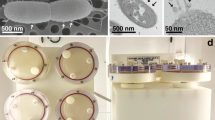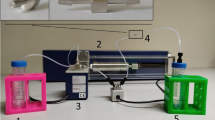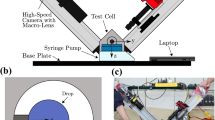Summary
A methodology is presented to culture Fall Armyworm Ovary cells in simulated microgravity using a novel bioreactor developed by NASA, the High-Aspect Ratio Vessel. In this vessel, the growth and metabolic profile for these insect cells were profoundly different than those obtained in shaker-flask culture. Specifically, stationary phase in the NASA vessel was extended from 24 h to at least 7 d while cell concentration and viability remained in excess of 1 × 107 viable cells/ml and 90%, respectively. Measurements of glucose utilization, lactate production, ammonia production, and pH change indicate that simulated microgravity had a twofold effect on cell metabolism. Fewer nutrients were consumed and fewer wastes were produced in stationary phase by as much as a factor of 4 over that achieved in shaker culture. Those nutrients that were consumed in the NASA vessel were directed along different metabolic pathways as evidenced by an extreme shift in glucose utilization from consumption to production in lag phase and a decrease in yield coefficients by one half in stationary phase. These changes reflect a reduction in hydrodynamic forces from over 1 dyne/cm2 in shaker culture to under 0.5 dyne/cm2 in the NASA vessel. These results suggest that cultivation of insect cells in simulated microgravity may reduce production costs of cell-derived biologicals by extending production time and reducing medium requirements.
Similar content being viewed by others
References
Alevriadou, B. R.; Eskin, S. G.; McIntire, L. V., et al. Effect of shear stress on 86Rb+ efflux from calf pulmonary artery endothelial cells. Ann. Biomed. Eng. 21:1–7; 1993.
Becker, J. L.; Prewett, T. L.; Spaulding, G. F., et al. Three-dimensional growth and differentiation of ovarian tumor cell line in high aspect rotating-wall vessel: morphologic and embryologic considerations. J. Cell. Biochem. 51:283–289; 1993.
Cherry, R. S.; Papoutsakis, E. T. Hydrodynamic effects on cells in agitated tissue culture reactors. Bioprocess Eng. 1:29–41; 1986.
Croughan, M. S.; Wang, D. I. C. Growth and death in overagitated microcarrier cell cultures. Biotechnol. Bioeng. 33:731–744; 1989.
Diamond, S. L.; Sharefkin, J. B.; Dieffenbach, C., et al. Tissue plasminogen activator messenger RNA levels increase in cultured human endothelial cells exposed to laminar shear stress. J. Cell. Physiol. 143:364–371; 1990.
Goodwin, T. J.; Jessup, J. M.; Wolf, D. A. Morphologic differentiation of colon carcinoma cell lines HT-29 and HT-29KM in rotating-wall vessels. In Vitro Cell. Dev. Biol. 28A:47–60; 1992.
Goodwin, T. J.; Prewett, T. L.; Wolf, D. A., et al. Reduced shear stress: a major component in the ability of mammalian tissues to form three-dimensional assemblies in simulated microgravity. J. Cell. Biochem. 51:301–311; 1993a.
Goodwin, T. J.; Schroeder, W. F.; Wolf, D. A., et al. Rotating-wall vessel coculture of small intestine as a prelude to tissue modeling: aspects of simulated microgravity. Proc. Soc. Exp. Biol. Med. 202:181–192; 1993b.
Jessup, J. M.; Goodwin, T. J.; Spaulding, G. Prospects for use of microgravity-based bioreactors to study three-dimensional host-tumor interactions in human neoplasia. J. Cell. Biochem. 51:290–300; 1993.
Kamen, A. A.; Tom, R. L.; Caron, A. W., et al. Culture of insect cells in a helical ribbon impeller bioreactor. Biotechnol. Bioeng. 38:619–628; 1991.
King, G. A.; Daugulis, A. J.; Faulkner, P., et al. Growth of baculovirus-infected insect cells in microcapsules to a high cell and virus density. Biotechnol. Lett. 10:683–688; 1988.
Maiorella, B.; Inlow, D.; Shauger, A., et al. Large-scale insect-cell culture for recombinant protein production. Bio/Technology 6:1406–1410; 1988.
McQueen, A.; Meilhoc, E.; Bailey, J. E. Flow effects on the viability and lysis of suspended mammalian cells. Biotechnol. Lett. 9:831–836; 1987.
Murhammer, D. W.; Goochee, C. F. Sparged animal cell bioreactors: mechanism of cell damage and pluronic F-68 protection. Biotechnol. Prog. 6:391–397; 1990.
Nollert, M. U.; Hall, E. R.; Eskin, S. G., et al. The effect of shear stress on the uptake and metabolism of arachidonic acid by human endothelial cells. Biochim. Biophys. Acta 1005:72–78; 1989.
Petersen, J. F.; McIntire, L. V.; Papoutsakis, E. T. Shear sensitivity of cultured hybridoma cells (CRL-8018) depends on mode of growth, culture age and metabolite concentration. J. Biotechnol. 7:229–246; 1988.
Prewett, T. L.; Goodwin, T. J.; Spaulding, G. F. Three-dimensional modeling of T-24 human bladder carcinoma cell line: a new simulated microgravity culture vessel. J. Tiss. Cult. Meth. 15:29–36; 1993.
Tramper, J.; Williams, J. B.; Joustra, D., et al. Shear sensitivity of insect cells in suspension. Enzyme Microb. Technol. 8:33–36; 1986.
Wang, M.-Y.; Kwong, S.; Bentley, W. E. Effects of oxygen/glucose/glutamine feeding on insect cell baculovirus protein expression: a study of epoxide hydrolase production. Biotechnol. Prog. 9:355–361; 1993.
Webb, N. R.; Summers, M. D. Expression of proteins using recombinant baculoviruses. Technique 2:173–188; 1990.
Author information
Authors and Affiliations
Rights and permissions
About this article
Cite this article
Francis, K.M., O’Connor, K.C. & Spaulding, G.F. Cultivation of fall armyworm ovary cells in simulated microgravity. In Vitro Cell.Dev.Biol.-Animal 33, 332–336 (1997). https://doi.org/10.1007/s11626-997-0002-9
Issue Date:
DOI: https://doi.org/10.1007/s11626-997-0002-9




